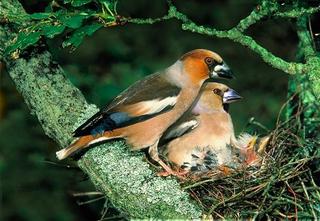
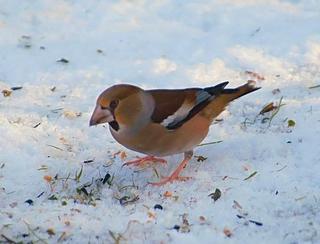
Worcestershire Record No. 20 April 2007 pp. 23-24
John Robinson
(During the 2005-2006 winter John Robinson recorded some excellent digital pictures of hawfinches. Many of these have appeared on bird-watching web sites. What follows is an account of his efforts to photograph these shy and elusive birds over many years. Ed).
I remember 1985 very well indeed.
I had been warden at Wyre Forest National Nature Reserve for some time, and had a pretty good idea where most species of plants and animals were to be found in the Forest. It was in the early days of the Goshawk era, and we were not supposed to even mention the bird by name. All the nest sites were known, and often we would have dawn sessions watching the sites. I was working with a friend who had been working with the Wyre birds for some time and it was during these times that I first became acquainted with Hawfinches. I had seen them in the past at my previous reserve, Castor Hanglands, near Peterborough.
The ones in Wyre though, afforded me much better views and we would see them regularly singing at first light from the tops of 80 foot high Douglas Firs. By that time the Goshawks had done with their morning ritual screaming near the nest site and had moved away.
I also remember that year well because I found several Hawfinch nests and they were nothing like the ones on the “fag cards” I had collected as a boy. They were always supposed to nest on some pretty fruit tree branch festooned with blossom. It wasn’t like that at all. One was in a sapling young beech festooned with Honeysuckle and another was in the same climber in a Birch sapling. The end of a long horizontal branch of a Rowan was the site of another, and the last was in an Oak tree, 50 feet from the ground.
Nest photography is frowned upon today ,but it was the only way birds could be photographed in those days - there wasn’t the ability to get hold of long fast lenses and digital gear like today. I couldn’t afford the good stuff anyway. I was running a Pentax S1A and a second hand Optomax 135 lens.
The high Oak nest was the only one possible for photography as the others were close to public paths. The eggs in the Rowan nest shot up in the air and fell to the ground as a squirrel walked over the nest and jumped off the end of the branch onto the next tree. We sat and watched it do that. The Birch tree nest eggs disappeared – probably predated.
 |
 |
We had to use climbing irons to get to the nest and the hide was tied to the main trunk of the tree. Stretch material off an old sofa was stretched between branches and the hide was more like a cocoon. The nest was 4 feet away from the camera and the birds were the tamest I have ever photographed - and I’ve done a few in 50 years at it. We ended up with some good images and the birds reared four young successfully
That was twenty years ago.
My gear has changed a bit.. I now use a Nikon D100 with a 100-400mm Cosinon lens. I have a Nikkor 80-400VR but don’t use it that much. The birds really declined from then with many years passing with no sightings at all. The familiar bull headed bird and its seemingly laborious dipping flight became a rare sight. Over the last few years however, one or two have turned up again, in the winter, and are seen fairly regularly, around Lodge Hill Farm where I still live. The area gets busy in the early days of the year with watchers starting early on their “year lists”.
I have been trying for several years to get the birds to come to my drinking pools where I have permanent hides, but with no avail. I must have spent a fortune on sunflower seed. Many times the bird feed in the tops of the oaks, and are often seen feeding on buds with bullfinches.
Suddenly in December 2005 one appeared on the lawn in front of the kitchen window feeding with the chickens. I was able to grab the camera and get a few shots.
They were terrible.
The window glass distorted the image because of the downward angle, and it was after our first and only snow fall. You know how it is - a dark bird on a pure white background. Worse than a Blackbird in a coal house. The bird started to come quite often, and over a period I started to put the sunflower down in one particular place. It had to be sunflower, and the bird, a male would only stay and fill its crop for around one minute. But we noticed something strange. I had started to keep a log, and the bird was coming almost on the hour. For example if it came at 2o’clock it would probably be back at 3. By now I had managed to persuade my wife to let me leave the window open for long periods, and I had a black sheet hanging down with a hole for the lens inside the kitchen. I got pictures, but the bird was still quite way off - about 25 feet, and the “looking down” angle was not good.
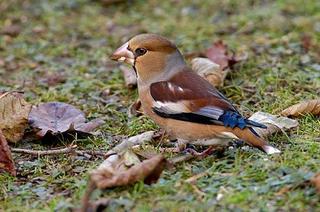 |
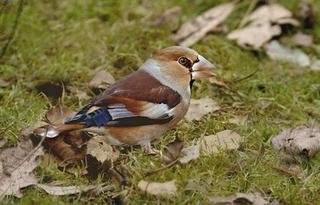 |
By now I had one of my hides up and had been moving this nearer to the feeding site which I had gradually moved away from the more open public area. The only reason for this was that the bird simply would not tolerate anyone within sight. Many hours were wasted because of people passing by and work going on at the reserve base nearby.
All this time I had been getting the bird used to a couple of feeding stumps but it nearly always used the ground - and only for a minute at a time. The seed had to be replenished every hour due to the multitude of other species which took a liking to the sunflower hearts - plus the squirrels and the chickens!.
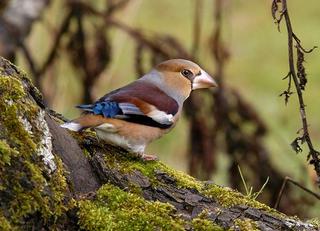 |
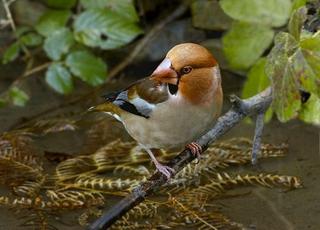 |
It was a tiring and often frustrating time. but worth it I think. Only a few pictures - but memorable ones.
At the time of writing the D100 has fell to bits. I managed to get a new D70s. The D100 cost £250 to repair. Since first writing this article and the bird has been back a couple of times. It also finally came to the drinking pool and I managed to get the one picture that has in effect taken me 30 years and a lot of hide time.
| WBRC Home | Worcs Record Listing by Issue | Worcs Record Listing by Subject |